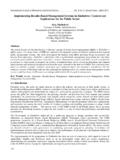Transcription of EARTHQUAKE LATERAL FORCE ANALYSIS
1 EARTHQUAKE LATERAL FORCE ANALYSISByByDr. Jagadish. G. KoriProfessor & Head Civil Engineering DepartmentGovt. Engineering College, Haveri-581110 EARTHQUAKE LATERAL FORCE ANALYSIS The design LATERAL FORCE shall first be computed for the building as a whole. This design LATERAL FORCE shall then be distributed to the various floor levels. the various floor levels. There are two commonly used procedures for seismic design LATERAL forces:1. Equivalent static FORCE analysis2. Dynamic analysisEquivalent static FORCE ANALYSIS The concept is a dynamic ANALYSIS into partly dynamic and partly static analyses for finding the maximum displacement. Is restricted only to a single mode of vibration of the static LATERAL FORCE ANALYSIS is based on the following assumptions,1) Assume that structure is ) Assume that structure is ) Assume perfect fixity between structure and ) During ground motion every point on the structure experience same accelerations4)Dominant effect of EARTHQUAKE is equivalent to horizontal FORCE of varying magnitude over the ) Approximately determines the total horizontal FORCE (Base shear) on the limitations of equivalent static LATERAL FORCE ANALYSIS In the equivalent static FORCE procedure, empirical relationships are used to specify dynamic inertial forces as static forces.
2 These empirical formulas do not explicitly account for the dynamic characteristics of the particular structure being designed or or analyzed. These formulas were developed to approximately represent the dynamic behavior ofwhat are called regular structures (Structures which have a reasonably uniform distribution of mass and stiffness). Structures that are classified as irregular violate the assumptions on which the empirical formulas, used in the equivalent static FORCE by step procedure for Equivalent static FORCE analysisStep-1: Depending on the location of the building site, identify the seismic zone and assign Zone factor (Z)Use Table 2 along with Seismic zones map or Annex of IS-1893 (2002)Step-2:Compute the seismic weight of the building (W) As per Clause , IS-1893 (2002) Seismic weight of floors As per Clause , IS-1893 (2002) Seismic weight of the As per Clause , IS-1893 (2002) Seismic weight of the building:Step-3 Compute the natural period of the building (Ta) As per Clause or Clause , IS-1893 (2002), as the case may.
3 Obtain the data pertaining to type of soil conditions of foundation of the building Assign type, I for hard soil, II for medium soil & III for soft soilStep by step procedure for Equivalent static FORCE analysisStep-5:Using Ta and soil type (I / II / III), compute the average spectral acceleration ( Sa/g) Use Figure 2 or corresponding table of IS-1893 (2002), to compute (Sa/g)Step-6: Assign the value of importance factor (I) depending on occupancy and/or functionality of structureoccupancy and/or functionality of structure As per Clause and Table 6 of IS-1893 (2002),Step-7:Assign the values of response reduction factor (R) depending on type of structure As per Clause and Table 7 of IS-1893 (2002)Step-8:Knowing Z, Sa/g, R and I compute design horizontal acceleration coefficient (Ah)using the relationship,Step by step procedure for Equivalent static FORCE analysisStep-9:Using Ah and W compute design seismic base shear (VB), from VB= AhW[ , IS-1893 (2002)]Step-10:Compute design LATERAL FORCE (Qi) of iStep-10:Compute design LATERAL FORCE (Qi) of ithfloor by distributing the design seismic baseshear (VB) as per the expression,Dynamic AnalysisDynamic ANALYSIS is classified into two types, namely, Response spectrum method and Time history methodTime History Method: Time history method of ANALYSIS , when used, shall be based on an appropriate ground motion and shall be performed using accepted motion and shall be performed using accepted principles of Spectrum Method.
4 Response spectrum method of ANALYSIS shall be performed using the design spectrum specified in Clause or by a site specific design , spectrum mentioned in Clause of IS 1893 (2002)Step by step procedure for Response spectrum methodStep-1: Depending on the location of the building site, identify the seismic zone and assign Zone factor (Z) Use Table 2 along with Seismic zones map or Annex of IS-1893 (2002)Step-2:Compute the seismic weight of the building (W) As per Clause , IS-1893 (2002) Seismic weight of floors As per Clause , IS-1893 (2002) Seismic weight of floors (Wi)Step-3:Establish mass [M] and stiffness [K] matrices of the building using system of masses lumped at the floor levels with each mass having one degree of :Using [M] and [K] of previous step and employing the principles of dynamics compute the modal frequencies, {w} and corresponding mode shapes, [ ].
5 Step by step procedure for Response spectrum methodStep-5: Compute modal mass Mk of mode k using the following relationship with n being number of modes consideredStep-6: Compute modal participation factors Pkof mode k using the following relationship with n being number of modes consideredStep by step procedure for Response spectrum methodStep by step procedure for Response spectrum methodComplete Quadratic Combination (CQC) method or Complete Quadratic Combination (CQC) method or Square Root of Square Sum (SRSS) methodTHANK YOUTHANK YOU







